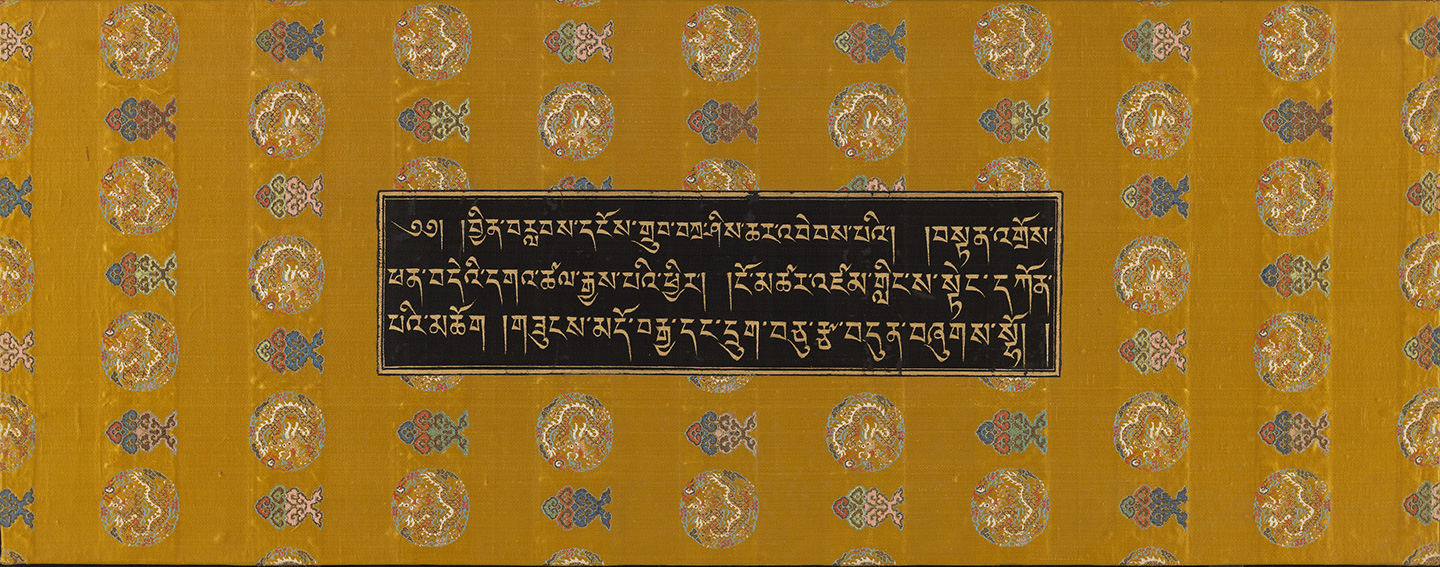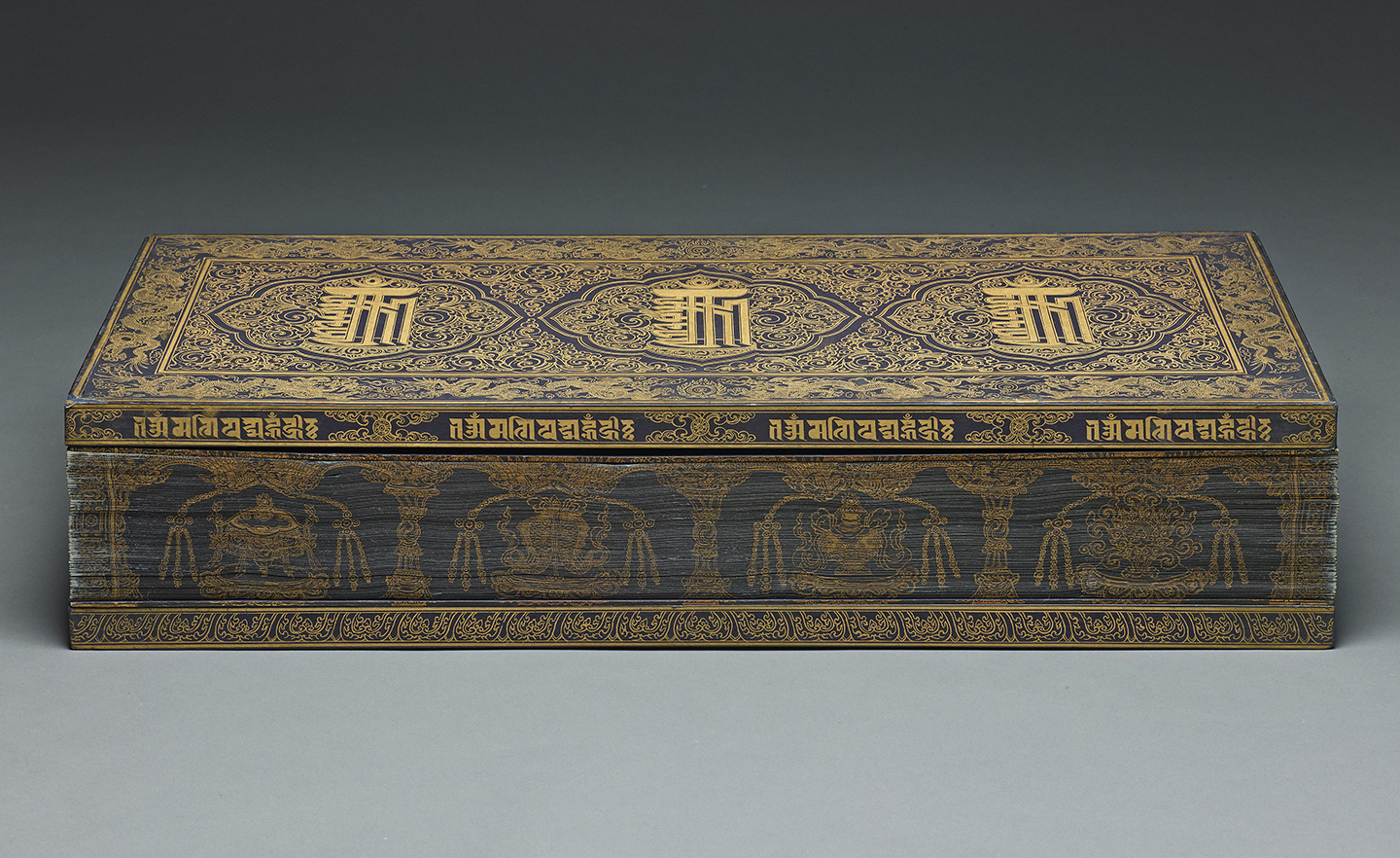With the widespread popularity of Buddhism achieved in China, the translation and transcription of Buddhist canons had become an important state enterprise for the central governments of the dynasties that followed. Not long after the Manchu entrance into China proper, the Grand Empress Dowager Xiaozhuang (1613-1688) asked her grandson the Kangxi emperor (1654-1722) to commission a transcription of the Kangyur in gold ink. The project started in the 9th month of the 6th year of his reign (1667), with more than 170 monks recruited to work on the transcription. It was completed in the 3rd month of his 8th reign year (1669). In the 12th month of that year the manuscripts were placed in the Cininggong Palace for worship. Costing over 400,000 silver taels, the collection comprises 108 cases of manuscripts forcefully and elegantly handwritten in saturated gold ink. The images on the cover planks are painted with vivid colors and exhibit a spiritual flair, and the wrappers for the paper leaves are made of the most refined materials with fine embroidery work, manifesting the culmination of the art of book production in China. Of the existing government-sponsored productions of Tibetan Buddhist canons, the Kangxi Kangyur is the earliest, the most voluminous, and the most extravagantly decorated.
Zhupin Jizhoujing (Sūtra of Various Mantra Collections)
- Court manuscript edition written in red-inked Tibetan script, Kangxi reign, Qing dynasty
It is a Tibetan custom to work on a shorter Buddhist text before moving on to a longer text. Thus, the Kangxi Kangyur project was preceded by the transcription of the Mantra Sūtra in red ink on white paper. The transcription of the shorter text started on the 7th day of the 9th month of the 6h year of the Kangxi reign (1667) and was intended as a measure for transcribers to practice arranging the number of columns and characters. The Mantra Sūtra is an extension of the Collection of Dhāraṇīs compiled by Tāranātha (1575-1637), a renowned scholar of the Jonang School of Tibetan Buddhism, and comprises the Dhāraṇīs and 181 minor sūtras. The manuscript is bound in the Pothi (or loose-leaf) style and protected by two outer and inner cover planks at the front and back. The inner cover plank up front is decorated with multicolored Buddha Śākyamuni and Buddha Vajradhāra; between the buddhas are written reverential sentences in Sanskrit and Tibetan. The rear cover plank is adorned with the images of Śakra and the Four Heavenly Kings. Between the planks are paper leaves with texts written in red-inked standard Tibetan script recto and verso. The first four pages contain four, five, six, and seven columns, respectively, while the rest contain eight columns. The paper leaves are sandwiched between cover planks, wrapped in fabric, and then secured with bundling straps. The Kangxi Kangyur also follows this layout and binding format.
Zangwen Longzang Jing (Tibetan Dragon Canon)
- Handwritten in gold-inked Tibetan script, 8th year of the Kangxi reign, Qing dynasty
The making of the Tibetan Dragon Canon (or
Kangxi Kangyur) marks the zenith of the art of book production in historical China. The manuscript is bound in the accordion style, which originated in the palm-leaf binding of ancient India. Each volume or case is made up of paper leaves with texts and protective accessories such as cover planks and wrappers.
The text of the Kangxi Kangyur is written in the Uchen script (dbu can) on indigo blue paper leaves. Each leaf is 87.5 cm long and 33 cm wide, with eight lines of elegantly transcribed texts on each of the two sides. Two small circles can be seen on the paper leaf, one either side; they represent the small holes for binding cords, threads, or wooden pegs to pass through. Such holes are commonly found in palm-leaf binding, but the circles in this collection are purely ornamental. Each page is framed with foliage patterns drawn in gold ink, and volume and page numbers are written on the front left-hand side. Each volume consists of around 300 to 500 leaves, the edges of which are decorated with hand-drawn gold-inked Eight Auspicious Symbols.
The Kangxi Kangyur's protective accessories comprise two layers of cover planks at the front and back, wrappers, and bundling straps. To demonstrate imperial grandeur and utmost respect for Buddhist classics, the accessories boasts the finest materials and refined embroidery work, and decorated with magnificent images and revered mantras. Made of solid lacquered wood, the outer cover planks on front and back are slightly bigger than the paper leaves, measuring approximately 92.1 cm wide, 36.6 cm long, and 5.3 cm thick each. The front side is curved, and the back flat. Both sides are decorated with incised inscriptions inlaid with gold. On the front side of the plank are Sanskrit inscriptions written in the stylized Rañjanā script. In the middle is written "oṃ-maṇi-padme-hūṃ," a six-syllable mantra, which is surrounded by a frame consisting of further inscriptions of mantras for the Five Dhyāni Buddhas, the Four Buddha-mothers, and the Three Protectors of the Dharma. On the back of the plank are five lines of Sanskrit mantras transcribed in Tibetan script, and the right and left sides of the plank are carved with the wish-fulfilling jewels and fierce monster faces (kīrtimukha) that compel all demons.
The inner cover planks, one front and one rear, are lined with indigo blue paper and are of the same size as the paper leaves. The frame on the front side is adorned with ten lively pearl-holding golden dragons, and within the frame are three lotus thrones with the monogram from the Kālacakra tantra (rnam bcu dbang ldan). The rear plank is decorated slightly differently, and within the frame are three crossed vajra (rdo rje rgya gram). The back of the inner cover planks is covered with five layers of colorful curtains to protect the images on the planks. The five colors - yellow, red, green, blue, and white - symbolize the Five Dhyāni Buddhas: Ratnasaṃbhava to the south, Amitābha to the west, Amoghasiddhi to the north, Akṣobhya to the east, and Vairocana in the center. The decorations on the curtains fall into two sets, with the yellow and red curtains adorned with Sanskrit and Tibetan mantras, and the green, blue, and white curtains adorned with the Eight Auspicious Symbols (bkra shis rtags brgyad). Beneath the curtains are multicolored Buddhist images. The front plank is decorated with two bodhisattvas and between them three lines of gold Sanskrit and Tibetan inscriptions in relief and the Salutation to the Triple Gem, while the rear plank is adorned with five dharma protectors.
All the wrappers are yellow-colored, and each volume of the Kangxi Kangyur is stored in the following order: paper leaves stacked by page number, the stack sandwiched between the front and the back inner cover planks then wrapped in plain silk, wadded cloth, and double-layered satin woven with flower patterns. The whole stack is then sandwiched between the outer cover planks, tied with the five-colored bundling strap, and finally wrapped in the wadded quilt.


